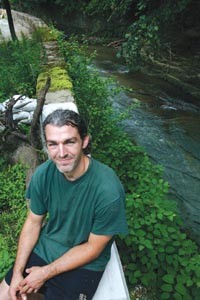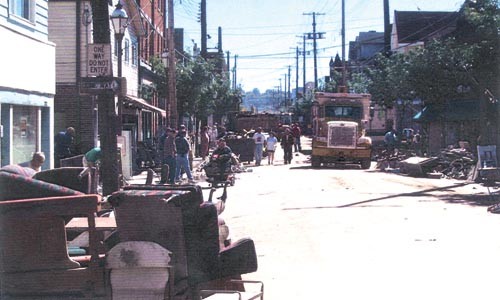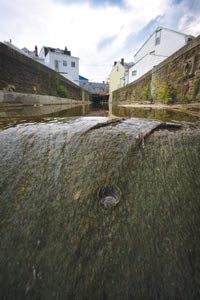... admit that the waters around you have grown.
-- Bob Dylan, "The Times They Are A-Changin'"
Brian Wolovich doesn't need many more reminders about how damaging floodwaters can be. The Millvale resident's bedroom window looks out into his backyard and over Girty's Run, the creek that snakes through the borough and has plagued it with nightmarish flooding in recent years.
One year ago this month, Girty's Run spilled over its walls twice in one week. The water's pressure caved in a door that covered the steps down to Wolovich's basement. During a flood, he says, "You scramble: What doesn't need to be saved? What can be saved? Throw your dog in the car and drive up the hill."
As the waters grow during a flood, "the noise is like a freight train back here," he says. And once it's over the walls, there's little to stop a body of water that big from moving where it wants to move. The feeling of dread doesn't soon go away.
Wolovich still lives in the midst of damage from floods past. On the right side of his property there's a gap where a vinyl fence. It was knocked down last year. On the other side there's a missing concrete fence, taken down in the even worse flooding that followed Hurricane Ivan, in 2004.
Parts of Wolovich's garden remain ungroomed because, with dredging and wall-replacement ongoing along the creek, "You don't know whether to replant the yard," he says.
Millvale is a working-class town that borders Pittsburgh along the Allegheny River. With the prosperous days of heavy industry long gone, the floods here can seem like insult added to injury.
But "the real shame of it," Wolovich says of the flooding, is that "all this is preventable."
Relative to '04, last year's flooding wasn't bad -- but it was hardly comfortable. During the first August 2007 flood, the water got into Wolovich's basement, wrecking his hot-water tank. He replaced it midweek, only to get hit again.
To make matters worse, during floods, sewage and storm water mix. When floodwaters top the wall, "This is all muck down here," Wolovich says. "I don't wish it on anybody. It's nasty." During last year's flood, his dog, Tiger, contracted an illness, resulting in thousands of dollars in vet bills.
Now, "In the months after August, every time it rains, you're saying, 'Shit, here we go again,'" Wolovich says.
For many of Wolovich's neighbors, last year's floods drummed up the memories of all the floods before -- and highlighted how little had been done in the years between.
However, adds Wolovich, having two floods in one week "was really our blessing in disguise" -- because it finally made the problem impossible to ignore. And indeed, flooding in river and creek communities like Millvale is changing the way the region thinks about its landscape, and helping to finally turn the rusty wheels of storm-water management here.
In 2004, a day after the Hurricane Ivan flooding, Millvale Councilor Vincent Cinski -- who has since become the borough's mayor -- returned from a fishing trip in Minnesota to find his community in ruins.
"I didn't know what had happened," he says. "There's no communications up there where we fish, so when I came back along Chartiers Creek, I said, 'Oh, my God. Something happened here.'
"Then we come into Millvale, and it was like a tunnel of garbage coming through town. It was like eight or 10 feet high, just all debris -- couches, refrigerators, whatever you can think of."
During the flood, water had its way with the borough. Cinski says whole cars were moved around. The basement of the borough office was filled with water.
"It's very devastating," Cinski says. "Your first thought is, 'We're done. How are we going to come out of this?' It was pretty depressing."
In the town's main business district, Fred Bohn Jr. -- who works with his father in Attic Records, on Grant Avenue -- says the flood destroyed 70 percent of his inventory.
Underneath the register, Bohn keeps a stack of photo printouts. In one shot, a bulldozer is buried behind a mound of records in the street. "How do you count stuff like that?" Bohn asks. "You don't count it, you just get it out."
In other pictures, the view down Grant is cluttered with garbage piles. The LPs in the foreground are already mildewed and warping in their soggy cardboard sleeves. That month, everyone was dumping trash into the street.
After the flood, the borough received promises from President George W. Bush that better times were ahead. "There is a future," the president reassured a crowd in Millvale on Sept. 22, 2004. "I predict to you, Mr. Mayor, that within a reasonable period of time this town is going to be back on its feet, better than ever, more hopeful."
The community started to scrape its way back. A sense of optimism and renewal grew. "Immediately, people were trying to salvage their homes," Cinski says. "Just within weeks the attitude had changed to 'We're going to make it.'"
But the 2007 floods washed away some of that cheer. "The '07 was the straw that broke the camel's back," says Bohn, adding that it reopened the old wounds and raised questions about how seriously people in power took the problem. "As soon as the news cameras left [in 2004], they left. ... It was just like it never happened. After the last one, people were just so disgusted."
Bohn says that people were still finding Attic Records' inventory in Girty's Run from the 2004 flooding. "After the 2004 flood, they left [the creek] the way it was," he says. "All the debris was still in the creek."
"Absolutely, people were upset" after the 2007 floods, Cinski says. "I guess we just weren't that high of a priority at the time. I think they thought that they had calmed it down some and they were going to do more work. ... They were going to do it eventually."
Dredging of the creek was supposed to begin after Ivan in 2004, but government funding (and public attention) for projects like Girty's Run dried up in 2005. It wasn't until last year that the Army Corps of Engineers began dredging Girty's Run and reconstructing parts of the flood walls that had eroded.
"These kinds of [emergency] jobs aren't normally budgeted," says Dave Heidish, a civil engineer with the Army Corps who helped assess the damage after Ivan. "The other big problem was you had Hurricane Katrina right after this." After Katrina hit in 2005, rebuilding New Orleans and the rest of the Gulf Coast became a federal priority, squeezing the funding to places like Millvale.
In some parts of Girty's Run, the Corps removed sediment to lower the creek's bed to pre-Ivan conditions. Along other sections, walls are being patched or replaced to prevent further erosion. Heidish says that though the Army Corps expects to finish by November, additional work and maintenance will have to be completed later.
The dredging and reinforced walls let the creek hold more water. But a severe storm like Ivan -- the sort of storm some studies say may become more common as Earth's climate warms -- could easily push those limits.
Even with the work being done along Girty's Run, "you're going to have flooding," Heidish adds. "There's no way around [it]. The problem is the development upstream. It just gets down here so much faster."
Millvale sits at the base of the Girty's Run watershed -- a stretch of terrain that inlcudes parts of Pittsburgh, Etna, McCandless, Reserve, Ross, Shaler and West View, all of which drain into that stream. Development upstream means that forests and open ground are replaced with strip malls and other projects. Trees and soil, which soak up rainwater, are swapped for concrete or asphalt that simply speeds it to the stream. Just a few miles north of Millvale, six lanes of McKnight Road run through a cluster of strip malls and fast-food restaurants. On top of a hill, a sea of parking lots surrounds Ross Park Mall, and the trees are isolated in raised islands.
Teh Rapid growth of upstream communities has played a major role in downstream flooding. And digging out the creek doesn't solve the problems posed by such terrain. "All we can do is address the limits of the Corps' flood-protection project in Millvale," Heidish says. "We're addressing what we can address here."
The real answers will have to come from planning on a level bigger than Millvale, throughout the floodplain and beyond.
"Everything that happens upstream affects us," says Mayor Cinski.
Behind Wolovich's Millvale house, the Corps has dug the creek down about four or five feet, and replaced a temporary wall with a solid cement one.
"This gives us breathing room," Wolovich says, but "this is no permanent fix. There needs to be a plan for maintenance." One thing is clear: "Three times in three years -- that's not a plan that is working."
But the Pittsburgh region's failure to plan has been a problem for much longer than that. Starting more than a century ago, wrote Joel Tarr and Edward Muller in Tarr's 2003 essay collection, Devastation and Renewal, urban development "created a need to dispose of both storm water and domestic wastes." And so the city's landscape was transformed from "one marked by flowing streams and a healthy stream ecology into a site almost completely devoid of waterways except for the large rivers."
Meanwhile, neglected infrastructure and shortsighted planning region-wide have created an especially disgusting dilemma when it floods. At that point, "everything is all mixed up," says John Schombert, executive director of 3 Rivers Wet Weather, a group that studies sewage and water issues. "Creeks are flooding into the sewage system. The sewage system is overflowing into the creeks. ... It's not treated at all. It's diluted with storm water, but that's about the best you can say about it."
"Channelizing" streams -- cutting them into big trenches and walling them off like waterslides, as has been done with Girty's Run -- has also proven problematic.
"When we channelize creeks, we're addressing the wrong end of the problem ... and we're actually increasing the velocity of the volume of water that's going through," says Court Gould, executive director of Sustainable Pittsburgh, a nonprofit that promotes environmentally conscious development. Additionally, "We're locking ourselves into long-term maintenance and just extending the time that we need to be addressing the upstream, real causes."
Roy Kraynyk -- executive director of the Allegheny Land Trust, a nonprofit that works to protect natural lands -- says all of that is a byproduct of attitudes toward land. The Pittsburgh region has had an "extraction mentality, going back to coal, mining for coal, [dredging] gravel out of the rivers," Kraynyk says. "Then carry it on to today where a lot of people see [land] as a blank canvas, waiting for the next development project."
"We're dealing with legacy issues," Schombert says, "things that are because of bad planning 100 years ago, not necessarily because of bad planning that's occurring today."
Unfortunately, the places paying the price for poor infrastructure and sprawling cement are not necessarily the ones best able to respond. Almost half of the households in Millvale, for instance, have an annual income of less than $25,000, according to the 2000 census. By contrast, almost half of the households in much more populous Ross Township -- the upstream suburb that covers much of the Girty's Run watershed -- brought in more than $50,000.
Fixing the problem means re-evaluating how we treat our environment, rethinking how we plan local development, and -- in more drastic instances -- relocating homes. Some communities are taking such steps.
Shaler Township, which borders Millvale to the northeast, has started buying up at-risk properties in an area in the Pine Creek floodplain. Shaler Manager Tim Rogers says Shaler has already purchased 38 homes and two vacant lots, and is looking to buy four more pieces of property.
Shaler's southwest corner sits in the Girty's Run watershed, but most of the township drains into Pine Creek. The reclaimed properties faced a dilemma similar to Millvale's: They sit at the bottom of a funnel.
The township is demolishing the houses, and the land left behind "will be permanent green space" where construction will not be allowed, Rogers says. Shaler targeted houses that had suffered repeated flooding, at least to the first floor. The program is voluntary and is supported by $4.9 million in federal and state money. Similar purchasing is going on in Hampton Township.
Helping flood victims get back on their feet diverts resources from other projects. "It takes so much time away from your public works," Rogers says. Cleaning up a flooded grassy lot, by contrast, requires a fraction of the cost of treating a flood-damaged house. Additionally,
"Credit should be given to Shaler Township," says Schombert. "They're saying, 'We're not going to build here. This area gets flooded. We're going to allow it to flood here.'"
Not every affected property-owner was interested in moving out, but Rogers says some residents have taken other precautions, including putting their homes on concrete blocks. By his estimate, about 40 more homes would fit the criteria for purchase -- if funding could be secured, and presuming the owners agreed to sell.
But moving people out of floodplains can be financially and politically difficult. It's also not practical for every community. "There's only so much you can do. In Millvale and Etna, where [people live] close to the stream, you've got to channelize the stream," Rogers says. Moreover, losing 40 pieces of tax-paying properties affects Shaler much less than it would a borough like Millvale: Shaler's population is about seven times Millvale's.
It's also going to take more than moving people out of harm's way. And in Millvale's case, preventive action upstream has been minimal. In Girty's Run-watershed communities like Ross, there are plans to install new retention ponds -- essentially, storm-water reservoirs -- and to survey the existing ones. But not all of the ponds are on public land, which makes it difficult to know what condition they're in.
And all the while, "The floodplains are growing because more water is coming down," says Kraynyk. "Removing those houses from the floodplains is a wise thing to do, but ... there's not a lot of work happening upstream to reduce the amount of water coming downstream."
Maybe that's because for 30 years, much of the state has been ignoring its own Storm Water Management Act.
On Oct. 4, 1978, Act 167 became law in Pennsylvania. The act correctly predicted what later flooding in Millvale and other communities would tragically confirm: Overdeveloping land along a body of moving water "increases flood flows and velocities," thus undermining downstream efforts to prevent flooding.
Act 167 requires each county to prepare and adopt storm-water-management plans for each of its watersheds. The municipalities in each watershed were to collaborate on a unified plan to regulate development to alleviate flooding. After the plan was approved by county and state environmental officials, each municipality was to adopt ordinances in accordance with it.
Unfortunately, "Twenty-five years went by and very few [municipalities] actually" adopted any plan, says Ty Gourley, of the Regional Water Management Taskforce, which works to improve water management and quality in Southwestern Pennsylvania. "There was a lack of funding and other issues."
Gourley says enforcement of Act 167 still lags because Pennsylvania's Department of Environmental Protection has "a small staff and a small budget to carry this out. ... They have their hands full [just] trying to help the communities that want to get it done."
But the tide is finally turning. A few years ago, in the absence of action by Allegheny County, 19 municipalities from the suburbs north of Pittsburgh -- including Ross Township, Pine Township, Shaler, Fox Chapel and Millvale -- took it on themselves to draft an updated storm-water plan for the Girty's Run, Pine Creek, Squaw Run and Deer Creek watersheds. (The county drafted its own plan for these watersheds in 1985, but Act 167 requires existing plans to be reviewed every five years.)
Wayne Roller -- executive director of the North Hills Council of Governments, to which these communities belong -- says the work started four years ago, with an inventory of what each municipality was doing on its own.
The update was crafted beginning in March 2005 by a committee led by Ross Township engineer Art Gazdik. Last December, it came before Allegheny County Council, where it passed 15-0.
"Why should the plans be updated?" asked county Councilor Jim Burn, who represents much of the area covered by the watersheds, at the Dec. 18 meeting. "I think that's obvious for a lot of reasons that we've experienced in the last three years."
In March, the DEP signed off on the plan, which means the municipalities must adopt the model ordinance by Oct. 5, 2008 -- almost 30 years to the day after Act 167 was first signed into law.
The ordinances will create uniformity throughout the watershed, so developers can't pressure officials into easing requirements by pitting municipalities against each other. Too often, the Allegheny Land Trust's Kraynyk says, local officials are so anxious for development that they exempt new developments from anti-flooding requirements. In the process, he says, these towns are "actually subsidizing storm events" in downstream places like Millvale.
The North Hills update requires developers to submit storm-water-management plans that prevent additional runoff and erosion. As the update notes, a "traditional drainage approach" has been to funnel the water offsite and trap it in a detention basin, a man-made pond, that releases the water into sewers or streams more gradually. The new plan instead promotes a combination of more natural designs, such as using permeable paving materials (which let water drain into the earth) or routing runoff from roofs onto lawns, reducing the volume of water rushing into the sewers.
The update also lays out guidelines for redevelopment of existing property, and states that only Allegheny County can grant a waiver to the requirements.
Given that the update committee included engineers and managers from each of the affected communities, it seems unlikely the plan will face much bureaucratic opposition on the municipal level.
"The managers were pretty cordial about the whole thing," Roller says. "I think they realize we're all in the same boat."
Roller and Ross Manager Tom Lavorini say they haven't heard any complaints from developers about the updated regulations. "They're going to come to the realization very shortly, if they haven't already, that this is on the way in," Roller says, pointing out that other parts of the state are going through the same updating process.
James Eichenlaub, director of government affairs for the Builders Association of Metropolitan Pittsburgh, says that he's unfamiliar with the update and hasn't heard from any developers about it.
But, as the municipalities begin to advertise the new ordinances, opposition may yet arise.
"Basically, what it will end up doing is increasing the cost of land development and providing homes," says Jack Trant, CEO of the Wexford-based Trant Corporation, which provides surveying and engineering for developers throughout Western Pennsylvania. "They can micromanage the storm water all they want, [but] focusing on an individual land developer is not really going to solve the problem."
Trant says that with so much of the watershed already built on, "demonizing" and regulating developers is not the best answer. "I think [officials] need to focus on the streams themselves, the channels and what's been built around them, to open up and let the water get through," he says.
But even these rules constitute just one step in getting the county -- let alone the state -- up to speed on storm-water management. Allegheny County, for instance, has yet to develop similar plans for the remaining 100 or more municipalities within its borders.
"What's alarming to me [is that] this is only 19 or 20 municipalities, and they are on the cutting edge of this type of requirement," Burn said at the December council meeting. "The other municipalities are not up this far yet. And no one can dispute the fact that this is going to happen again and again and again until we get caught up."
Indeed, even among those North Hills communities that may be working to comply with flood-control laws, "we have fallen grossly behind in storm-water management in Allegheny County," Burn added. "We need to find ways to cut through the bureaucracy and cut through the red tape because flood waters are looming faster than the red tape and we are falling behind.
"This will help us get caught up. But ... this is still going to take years to implement some of the things that are in here."
Ironically, if communities in watersheds like Girty's Run are further along in addressing flood-control issues than those elsewhere, it's largely because of floods like the ones that devastated Millvale.
"It's been a long road to get there, and those [flooding] events merely bolstered their dedication to getting it done," says Gourley, of the Regional Water Management Taskforce. "I think by and large, most of the counties are starting now, but some of that movement has just happened in the last three or four months."
However, getting other counties to follow through is critical. Otherwise, businesses might simply opt to avoid Allegheny and its new rules. If other counties "take advantage of us ... the companies will go that way because it may be less stringent for them to do that," said county Councilor Matt Drozd, who also represents some northern suburbs, at the December meeting. "We don't want to lose jobs in Allegheny County." Watersheds and streams, Drozd added, do not respect municipal borders.
And within Allegheny County, there's still much to be done.
Forests, which are often the first casualties of new development, are also among the most useful tools for reducing floods. The Allegheny Land Trust's Kraynyk says woodlands can intercept upward of 76 percent of annual precipitation before it reaches the streams. But given the events of the last four years, simply protecting the forests might not be enough.
"Think about it," Kraynyk says. "Protecting the woodlands is maintaining the status quo" -- which means waiting for more floods. Replanting previously developed lands, by contrast, can actually increase the amount of water that is intercepted.
Kraynyk also says municipalities could start assuring that development isn't leaving only unusable land behind. "The open space that is left over from a development is usually your steep slopes," which are hard to plant on, he says. He proposes that municipalities require terraces in those slopes, to promote planting.
Ideas like Kraynyk's work better the more widely they are implemented -- a fact which highlights the importance of getting all communities to update their storm-water-management plans.
"All 67 counties right now are 21 years past due for getting this done," says Barry Newman, who took over as chief of storm-water planning and management for the state Department of Environmental Protection four years ago.
Newman says 37 counties have signed agreements with the state for the DEP to prepare countywide plans. Another 15 are currently negotiating a deal. Allegheny County is among the remaining 15 counties, which are the farthest from setting up a countywide plan.
The sheer number of municipalities in Allegheny County, explains Newman, and the variations in codes and planning in each, have made it hard to get things going.
"We don't have a strategy in place yet for tackling Allegheny County," Newman says. "We have ideas, but we and Allegheny County have not yet reached an agreement on how to tackle the county."
If following a 30-year-old state law were all it took to prevent floods, we'd be in much better shape. But alongside policy changes and updating codes, clean-water advocates are also trying to change a culture of environmental abuse that runs deep to the region's industrial roots.
"I think we need to change the land ethic," says Kraynyk. "The land ethic around here, and in general, is that land is a commodity by which we can extract resources and make a profit. It's not seen as a functional ecosystem that is providing a highly functional, natural service that benefits the public."
But there are signs that attitudes are changing. For instance, the Nine Mile Run Watershed Association, an East End advocacy group, has attached about 700 55-gallon rain barrels to the downspouts of homes in communities that drain into Nine Mile Run, a Monongahela River tributary. The barrels hold storm water that would otherwise overwhelm sewers and streams.
Kraynyk believes that people are starting take responsibility for the world around them. "I don't think it's a trend. I don't think it's a fad," he says. "I think people recognize the economic benefits, the health benefits, the image benefits of a green, healthy city."
And as Pittsburgh continues its quest to redefine itself, the region's rivers and unique topography -- which long ago impressed explorers -- will have to re-emerge.
"The rivers are regarded much more positively than they have been in the past," says historian Joel Tarr. "I think it's true that more people use the rivers as we attempt to attract tourists."
But beyond sprucing up the highly visible rivers, says Sustainable Pittsburgh's Court Gould, we could be doing more to bolster our image as a natural cityscape. "Historically, there were lots of streams open and free in Pittsburgh, but over time we've encapsulated, culverted and piped those streams," he says. "A stream that's brought back, and safely put to use in its natural form, can become a beneficial community amenity, with walking paths and trails along it."
And that's something Brian Wolovich can attest to. With his Millvale address just minutes from the city, he's got the kind of tranquil backyard that many people dream of -- when it's not overflowing, at least.
"I wake up in the morning, I've got birds singing," he says. Having lived through a flood, Wolovich admits that if someone were to offer him a fair buyout, he'd consider it. In the meantime, however, "Three hundred and sixty-four days of the year, it's great living back here."


























